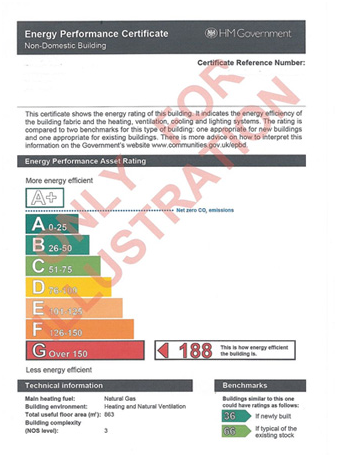Commercial EPC
Commercial EPC
The Energy Performance Certificate (EPC) looks broadly similar to the energy labels now provided with vehicles and many appliances. Its purpose is to indicate how energy efficient a building is, therefore the better the rating the more favourable the running costs are likely to be.
An EPC is required as soon as the building is in the process of being offered for sale or let. For the sale of a property it is the responsibility of the seller to make available an EPC to prospective buyers. For a letting it is the responsibility of the prospective landlord to make available an EPC to the prospective tenants. The EPC is intended to inform potential buyers or tenants about the energy performance of a building, so they can consider energy efficiency as part of their investment or business decision to buy or occupy it.
“An EPC from Envirogood could increase your asset value” Once produced, the EPC will show an energy rating for the building – a theoretical value based on the performance potential of the building itself and its services. It is accompanied by a recommendation report, which provides cost effective measures on how the energy performance of the building could be enhanced, together with an indication of the payback period.
To ascertain whether you are required to provide an EPC for a building, or a part of it, please contact us for more information.

Since 2009, as part of the Energy Performance of Buildings Directive (EPBD) issued by the EU, all buildings in the UK that are constructed, sold or offered for rent need an EPC.
• An EPC is required whenever a property is marketed
• The EPC is valid for 10 years
• This applies to all sellers hoping to sell their property and to landlords offering a property for rent
The Energy Performance Certificate (EPC) is a European Union (EU) initiative as part of the drive to improve energy efficiency across the EU member countries. An EPC provides two key pieces of information:
• The energy efficiency of a property
• The environmental impact of a property
The EPC provides a rating of a property’s energy efficiency and displays this as a graph, similar to those found on kitchen appliances. Ratings come on a scale of A-G, with A being the best rating. This means that homeowners and occupiers can compare the energy efficiency of different properties in a similar way to comparing the energy performance of fridges or freezers.
The EPC also includes a Recommendation Report which lists the potential improvements that can be made to a property in order to:
• Cut fuel bills
• Improve energy efficiency
• Help cut carbon emissions
The EPC is split into the following four sections:
1. The performance and environmental impact of the property
2. Estimated energy use based on standard occupancy assumptions
3. A summary of energy performance features
4. The recommendations for improving the energy efficiency
An EPC can only be produced by a Domestic Energy Assessor (DEA) or a Home Inspector (HI) who is a member of an approved Government Accreditation scheme. The energy assessor will visit the property to determine the energy related features. These are then entered into a computer program which has a calculation model developed by the government and is known as Reduced Data Standard Assessment Procedure (RDSAP).
When collecting the RDSAP data the energy assessor will need to determine the following:
• Property type
• Age of property
• Type of construction
• Property dimensions
• Room and water heating systems
• Insulation levels
• Windows and glazing types
• Types of lighting
This information will be entered into the calculation software and an EPC will be produced.
